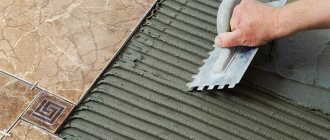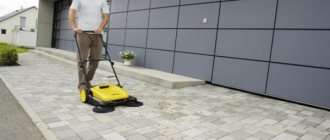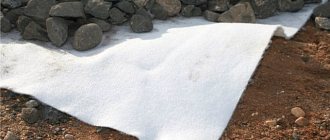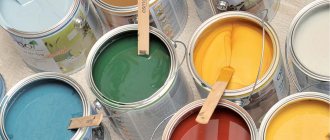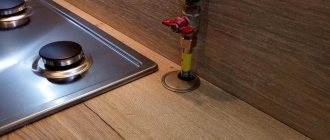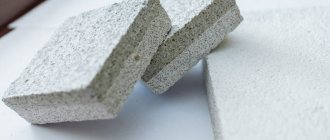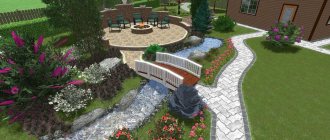Geotextile is a non-woven material that consists of polymer fibers (polypropylene, polyamide). This material is produced in several types. In this article we will consider the main advantages and disadvantages of geotextiles and their areas of application.
Types of woven geotextile fabric:
- Knitted geotextile is the cheapest in cost, it is easily destroyed under mechanical loads, the fabric simply unravels when damaged. It is not recommended to use this material in construction.
- Woven geotextile - fibers are connected by weaving, this is a more durable material. Widely used in landscape construction for drainage.
- Thermally bonded geotextiles - the fibers in this material are subjected to thermal and chemical treatment. This material already has sufficient strength for the construction of drainage systems.
- Needle-punched geotextiles are the most versatile, but also expensive material when compared with the above. It filters liquids well, has high strength, and can be used on any soil.
Characteristics of geotextiles:
- The material is not flammable;
- Environmentally friendly;
- It filters water well and retains particles of silt and sand, so there is no mixing of different layers in building structures;
- Works well in various temperature conditions (-60 - +90 degrees);
- Service life is about 25 years;
- Does not rot and is not damaged by rodents.
Composition and types of geotextiles
Geotextiles are similar to ordinary fabric, but they can have different structures. This material consists of the finest synthetic threads, which are pressed together and are of a polyester or polypropylene nature.
Depending on the dominant ingredient in the composition, geotextiles come in the following types:
- Polyester. The material consists of thin fibers. Polyester geotextiles are environmentally friendly, but they have low resistance to acids and alkalis.
- Polypropylene. Durable and reliable material that does not rot or mold. This type of geotextile has an excellent filtration coefficient.
- Combined. This type is made from various recyclable materials. It has a low cost, but is inferior to polypropylene and polyester material in strength and durability. Combined geotextiles include natural additives that quickly rot. In their place, voids form, increasing the likelihood of damage to the product.
Varieties and selection criteria
To understand what geotextiles to use for garden paths, without drowning in the assortment of brands and names, it is useful to have an idea of the types of fabric. Material can be classified by raw material; The basis for production is polypropylene or polyester fiber.
Geotextile based on polyester is budget-friendly and environmentally friendly, but is especially sensitive to alkaline and acidic environments, and, as a result, less durable in use than polypropylene material. There are varieties of organic-based fabric, coconut fiber and jute. Their environmental friendliness results in fragility: the resource does not exceed 5-6 years. Mixed or recycled textiles have the same service life.
Thermally bonded geotextile Source st0.isolux.ru
The geotextile can be classified in another way: by the type of fiber connection. The production of woven geotextiles is carried out in a traditional way for fabrics, when weft and warp threads perpendicular to each other are intertwined. Material with high tensile strength is used for reinforcing highways, retaining walls, and embankments.
Woven textiles with a lower strength rating are suitable for landscape design. With its help, the soil is strengthened, including on slopes. Woven material is not recommended for filtration and drainage.
Geosynthetic material of the second type is non-woven, divided into needle-punched and thermally bonded. Needle-punched geotextiles are made mechanically, using a press with needles. Polypropylene or polyester fibers penetrate each other when pierced; the result is a fabric resembling felt. Its main quality is its ability to pass water, which is ideal for use in drainage systems.
Laying tiles Source www.suncityvillas.com
Which geotextile to choose?
needle-punched geotextile
dornite
Heat set
Heat treated
Knitted, with stitching
construction
The choice of material depends on its purpose. The most popular options:
- Needle-punched. This tissue is produced by bonding microscopic fibers together. Moisture passes through its structure, so the material will not be flooded by precipitation.
- Doronite. This geotextile is suitable for constructing a reinforcing substrate and has excellent filtration properties.
- Heat set. The fibers of this geotextile are carefully melted together through heat treatment. This production technology gives the material high strength. However, the heat-fixed variety has low filtration properties, because its structure allows moisture to pass through only in the transverse direction.
- Heat treated. The ingredients are fused and pressed together at the same time. As a result of this processing, an extremely dense and reliable material is obtained. Most often, this geotextile is used for waterproofing.
- Knitted, with stitching. The fibers of this material are tied together with strong threads. Knitted geotextiles effectively pass liquid through their structure, but have low resistance to mechanical loads.
- Building. This material allows liquid to pass through only from the inside, so it can be used for waterproofing.
It is necessary to select material for arranging garden paths taking into account the following criteria:
- Density. The throughput of the geotextile fabric depends on this factor. The density of the drainage material should be in the range from 150 to 300 g/m³. The pore size should be 175 microns. If the density of the geotextile is lower, it will be less durable.
- Filtration coefficient. This indicator indicates the water permeability of the material. The optimal value for drainage material is from 100 to 300 m/day. The exact indicator is selected depending on the groundwater level, the volume of climatic precipitation and the degree of soil permeability. If the garden area is regularly moistened, it is recommended to take a canvas with the highest filtration coefficient.
- To arrange a garden or summer cottage, you can choose any type of geotextile. However, experts recommend giving preference to polypropylene material, which is made of smooth and durable monofilament. This fabric is characterized by increased resistance to silting. In addition, you can use the heat-bonded type, because needlepunch quickly silts up and does not allow moisture to pass through well.
- It is not advisable to lay woven material under garden paths, because... its fibers quickly rot in the soil.
- The tensile strength level of garden geotextile fabric must be at least 1.9-3 kN/m. The resistance of the product to punching must be selected based on what material will be used for drainage, as well as how deep the drainage system will lie and how intensely the soil will move. In most cases, an indicator of 400-500 N is sufficient. When using large crushed stone, this geotextile indicator should be higher. All necessary information can be found on the product packaging.
- Financial savings. This factor is of great importance. When choosing a canvas, you need to choose the right ratio of quality and cost. Most often, the price of geotextiles ranges from 10-20 rubles. for 1 m². The cost of imported high quality material can reach 200-300 rubles. for 1 m². At the same time, Russian products are not inferior in quality and reliability to many imported analogues
Use of geotextiles in construction
This material is widely used in the construction of foundations; it performs filtering functions that prevent siltation of the structure and extend the overall service life of concrete. When constructing a foundation, it is necessary to install a geotextile fabric slightly larger than the foundation area. After installing the main structure, the material is lifted onto the walls.
When constructing buildings with high groundwater levels, a deep drainage device is used. In this case, geotextiles are actively used. A cushion of 150-200 mm of crushed stone is made in the drainage trenches, then a roll of geotextile is spread. A crushed stone cushion is made again, drainage pipes are installed and a sheet of material covers them. In this case, the drainage will last much longer, since the geotextile will allow water to pass through and retain all small impurities.
Currently, this rolled material is widely used in road construction and for the construction of pedestrian paths. The base for these types of work is compacted and a crushed stone cushion is made. Then geotextiles are installed, a sand cushion is laid over the material, paving stones are installed, and monolithic concrete paths are laid. The entire complex of these works extends the service life of roads and pedestrian paths.
Advantages and disadvantages of geotextiles
This material has the following advantages:
- compact dimensions;
- small weight;
- high level of strength;
- affordable price;
- the ability to “breathe” (for Dornit geotextiles);
- easy and quick installation;
- easy transportation;
- the ability to maintain normal heat exchange in the soil;
- high resistance to chemical and mechanical influences;
- ability to inhibit weed germination, etc.
Disadvantages of geotextiles:
- low resistance to direct exposure to ultraviolet radiation;
- high cost of some types of material.
How can geotextiles be used on a site?
Geotextiles allow you to implement any ideas for geoplastic transformation of the landscape on a site. Using non-woven material, you can create new design compositions, transforming the appearance of the site.
Option #1 – improving the quality of garden paths
It is difficult to imagine a site without winding paths running deep into the garden. When planning their arrangement, you always want the result to be a beautiful and functional element of landscape design that will serve you well for more than one season.
The use of agrofibre allows you to maintain decorative properties and extend the service life of garden paths. After all, even installing a small path on a site requires a lot of effort: excavating soil, backfilling the underlying “cushion,” laying the coating itself. But during operation, when layers of gravel or sand gradually sink into the ground, depressions, bumps and irregularities begin to appear on the surface of the path.
A layer of geotextile laid between the soil and gravel backfill allows you to evenly redistribute the load and prevent mixing of layers
It is convenient to use non-woven material when arranging sandy paths and gravel areas. Geotextiles placed between the soil and the backfill material optimize compaction so that the fill material will have virtually no penetration into the soil. And this will significantly contribute to reducing the consumption of bulk material - and therefore overall savings. In addition, the canvas will facilitate the rapid outflow of water and prevent the germination of weeds and grasses. In swampy and soft areas of soil, non-woven material will even perform the function of durable reinforcement.
Option #2 – waterproofing artificial reservoirs
Decorative ponds are popular elements of landscape design. The arrangement of any of them, be it a miniature lake or a large swimming pond, requires the presence of a special waterproofing bowl.
When constructing a reservoir, the bottom of the pit is often lined with a layer of gravel or sand, on top of which waterproofing material is laid
During operation and cleaning of a reservoir, there is always a possibility of damage to the material by plant roots or the same stones. And the use of geotextiles will help make life much easier. It is enough to lay agrofibre under a layer of insulation so that you no longer have to worry about protecting the material from external damage.
If geotextiles are laid as a second layer on top of the waterproofing material, then the bottom of the reservoir can be safely laid out and decorated with river stones
Option #3 – arrangement of the local area
Agrofibre can be used to create open areas and design rocky gardens. The construction of today's popular patios with wooden terraces and decking also cannot be done without the use of geotextiles. It is laid as a soil base to eliminate the possibility of weeds growing through the boardwalk.
Recent Entries
Lilac perennials that are beautiful, compact and do not crowd out other plants Why when buying seedlings you should not take the sellers’ word for it and how to determine the age of the plant using 3 signs Tomato seedlings have turned purple or whitish: why the color has changed and how to save the plants
A material that allows the soil to breathe and has the ability to freely pass moisture will act as reliable protection for a terrace or area for a summer kitchen from the penetration of annoying ants and rodents
With the help of geotextiles, it is easy to separate and construct high embankments, strengthen surfaces and reinforce soils, drain the soil and provide sufficient filtration.
A layer of turf laid underneath will drain rainwater, thereby preventing erosion and significantly strengthening the slopes of an uneven surface. Also, geotextiles are indispensable when arranging children's playgrounds.
When making a children's sandbox, so that the sand does not trample into the ground and does not mix with the ground, you just need to cover the bottom of the pit with a layer of geotextile
Option #4 – arrangement of foundations and retaining walls
The strength and durability of any building directly depends on the reliability of its foundation. If we talk about concrete types of foundations, then considerable damage is caused to them by capillary wetting with groundwater. Thermally bonded geotextiles help improve the waterproofing of a monolithic foundation.
When arranging foundations, geotextiles are used to separate fine-grained soil and gravel fill in order to prevent mixing of layers, and at the same time capillary wetting of walls
The material can simultaneously perform two functions: to separate layers and provide effective drainage, preventing prolonged contact of the surface of the concrete base with moisture.
Option #5 – green roof
The “green” roofs that are popular today also cannot do without the use of non-woven material.
To prevent mixing of layers, agrofibre is laid between the drainage layer and humus, and to protect the roof itself - on top of the waterproofing
And when installing inversion roofs, the material is used to prevent loading material from getting between the insulation slabs. For these purposes, it is laid on top of a layer of insulation.
Geotextiles for garden paths
A beautiful garden plot requires properly and efficiently arranged paths. They can be constructed from different materials. Sometimes the marked strip is sprinkled with pebbles or crushed stone, after which the surface is carefully leveled.
You can arrange garden paths using granite or basalt paving stones. When constructing them, it is imperative to ensure that there is a good drainage system for water.
When arranging paths made of pebbles or gravel, it is enough to lay 1 layer of geotextile fabric. If additional paving is carried out with tiles, it is necessary to lay out an additional underlay. In this case, it is better to use 2 layers of geotextile.
Crushed stone paths on sandy and clayey soils must be constructed carefully, because the coating can quickly shift, bend or sink into the soil.
It is forbidden to lay tiles on dry mixtures, because with the arrival of cold weather, its surface will crack, and the monolithic concrete base will prevent water from draining.
THE MOST POPULAR TYPES OF GEOTEXTILES THIS MONTH
| Name | Density | Width | Length | Roll area, m2 |
| Geotextile 100 g/m2 | 100 | 2,15 | 130 | 279,5 |
| Geotextile 150 g/m2 | 150 | 2,15 | 100 | 215 |
| Geotextile 200 g/m2 | 200 | 2,15 | 100 | 215 |
| Geotextile 250 g/m2 | 250 | 2,15 | 100 | 215 |
| Geotextile 400 g/m2 | 400 | 2,15 | 50 | 107,5 |
Step-by-step instructions for installing garden paths
To achieve a good result, you need to first prepare the following materials and tools:
- required number of geotextile fabrics;
- tiles or paving stones;
- sand;
- crushed stone;
- shovel;
- rubberized hammer.
To begin with, the outline of the garden path is placed. For this purpose, you can use bricks, tiles, etc. To achieve maximum evenness, it is better to mark the contours with long cord and stakes.
Table: Application of geotextiles depending on density
| Application | 100 | 150 | 200 | 250 | 400 |
| For highways | + | ||||
| For garden paths | + | + | + | + | |
| Highways | + | ||||
| For drainage systems | + | ||||
| Parking lots | + | ||||
| Parking for heavy vehicles | + | ||||
| For sports fields | + | + | |||
| For the foundation of a low-rise building | + | + | + | ||
| For the foundation of a multi-story building | + | ||||
| In strengthening the slopes | + | ||||
| For blind area | + | + | + | ||
| In the roof | + | + | + | ||
| In agriculture | + | + | + | ||
| From weeds | + | + | |||
| In construction | + | + | |||
| On clay | + | + | |||
| Under sand and gravel | + | + | + | ||
| Under the paving stones | + | + | + | ||
| For garden | + | + | + | ||
| For landscape design | + | + | + | ||
| For gabions | + | ||||
| For pipelines | + |
Do you have any questions? Call now on the number
+7
Arrangement of slab-crushed stone path using geotextiles
The construction of a crushed stone path with a geotextile backing is carried out sequentially and according to the following scheme:
- First, paving stones or tile products are laid out on unprepared soil. This is necessary to calculate the amount of material and determine the boundaries of the structure.
- A trench is dug along the intended width. Its depth can be from 30 to 40 cm.
- The bottom of the recess is leveled. Everything unnecessary is removed from it, including plant roots and debris.
- After this, geotextiles are laid on the bottom surface. In this case, its edges should protrude 4-6 cm above the ground.
- Then crushed stone is poured. This layer should be about 14-15 cm thick.
- After this, it is necessary to lay the next geotextile layer.
- Fine sand is poured on top of the laid material. This layer should be 11-12 cm thick.
- The formed substrate must be compacted. After this, you can lay tiles or paving stones.
- After completing the laying of the paving material, you need to trim off the protruding parts of the geotextile fabric.
- Fine-grained sand should be poured into the cracks between tiles or paving stones. Additionally, the coating must be compacted by tapping its surface with a rubberized hammer. The path must be compacted until all the cracks between the tiles are filled with sand.
- At the final stage, you only need to decorate the edges of the path. To do this, you can sprinkle them with fertile soil with seeds of garden plants.
How to lay geotextiles correctly
For a long service life, it is important not only to select the correct geotextile, but also to install it without errors.
Laying rules
When carrying out work, you must adhere to certain rules:
- the surface for laying the canvas must be well leveled;
- the packaging is opened immediately before starting work, as some materials are sensitive to sunlight;
- calculate the required dimensions and cut the strips taking into account the supply of material, but also so that there are as few scraps left as possible;
- when calculating dimensions, you should take into account an allowance of 5–10 cm, which is necessary for slight deformation of the geofabric after covering it with sand on top;
- if geotextiles are laid on a layer of gravel or pebbles, then a single layer is used; when laid directly on the ground, the fabric is placed in 2 or 3 layers;
- geofabric is laid without tension, but folds should not be allowed to form;
- the overlap of the canvases must be at least 20 cm;
- The junctions of the canvases with each other must be well fixed. They can be fastened with a construction stapler or soldered with a construction hairdryer;
- when laying strips at joints, it must be taken into account that the geofabric laid on a higher area must cover the material from a lower area;
- after pouring crushed stone onto the geotextile, it is advisable to wrap its edges 15–20 cm from above to prevent contamination of the internal components;
- When fixing the material to the ground using long staples, the damaged areas must be glued with bitumen.
Step-by-step instructions for building a path with your own hands
Paths using geotextiles should be laid according to a certain algorithm:
- Mark the paths using pegs and a rope stretched between them.
- Dig a trench about 30–40 cm deep and level its bottom well.
- Fill with a layer of sand (preferably fine-grained river sand) up to 5 cm thick.
- Lay geotextiles on the sand cushion so that the edges of the material cover the slopes of the recess by 5–10 cm.
- Connect the joints using a stapler or solder them with a hair dryer.
- Pour a layer of fine crushed stone 15 cm thick and level it.
- Lay another layer of geofabric in the same way as the first.
- Cover with 10 cm of sand.
- Let stand for 2-3 days.
- Moisten the sand layer or cover it with tile adhesive.
- Lay the base covering.
Important! When using gravel or pebbles as the final covering, only one layer of geofabric can be laid, since these materials do not have much mass and will not cause significant subsidence of the structure.
When installing paths in their dachas, many owners wonder: why spend money on geofabric if you can save money. Experienced developers give a negative answer to this question. The use of geotextiles increases the service life of any structures by an order of magnitude, helping to maintain their original appearance for a long time.
Features of a track with a geotextile backing
A garden path equipped with geotextile fabrics will retain its configuration for a long time.
In this case, the crushed stone layer will be used as drainage, through which moisture will freely drain into the sand and soil. As a result, the layer is compacted, and the geotextile fabric ensures the unhindered removal of excess moisture.
Sand poured onto geotextiles acts as a cushion for decorative material laid out on the surface. If any tile product begins to sag, the path can be quickly and easily repaired. To do this, you just need to lift the settled element and sprinkle a little moistened sand under it, then compact it with a mallet.
Geotextile density
When choosing geotextiles for garden paths, you must pay attention to the density of the material. It is believed that the higher this indicator, the better the material in front of you. Density ranges from 17 to 600 g/m2 or more. The thinnest geotextiles are used to protect the soil from birds and to cover greenhouses and greenhouses.
To organize garden paths, material with a density of 100-250 g/m2 is useful. The choice is best made based on an analysis of the soil type and the characteristics of the site. So, if the territory is flat and the soils are stable, then it will be enough to use geotextiles with a density of 100-150 g/m2; if the soil is mobile and unstable, then it is better to use geotextiles with a density of 250 g/m2 or even more. In most cases, they settle on the option of 150-200 g/m2 - this is an excellent ratio of strength and price.
Other tasks of geotextile material in landscape design
Geotextile fabrics can improve the area and make many jobs easier. In addition, this material allows you to realize original ideas.
Geotextiles are used for fixing coatings and zoning, as well as constructing drainage and effectively cleaning the soil. If you lay this material under a turf layer, you can:
- slow down soil erosion;
- strengthen the hills;
- prevent the natural removal of beneficial compounds from the soil;
- prevent the growth of weeds whose roots cannot penetrate the dense layer of geotextile;
- ensure effective water drainage, etc.
How to lay it correctly
Before spreading the material, prepare boards or wire staples to secure it to the ground. The following steps (step by step):
- remove existing weeds from the garden bed;
- dig up the soil, apply fertilizer if necessary;
- level the surface with a rake;
- measure the width and length of the ridge;
- cut off the required amount of textile from the roll, taking into account that the allowance for fastening will require at least 15 cm;
- carefully spread the material over the surface of the soil, smooth side down, rough side up;
- level over the entire ridge;
- make cross-shaped cuts or cut out circles according to the planting scheme (seedlings are planted in these places or seeds are sown);
- The canvas is secured around the perimeter with boards, wire pins (staples) or sprinkled with earth.
After this, they begin planting crops. It is better to work in calm weather, following the instructions. Further care - watering, fertilizing, tying up plants - is carried out without removing the material.
A little about geogrid
Many gardeners use geogrids to landscape their plots. This structure is made of the same materials and using similar technology as geotextile fabric.
Geogrid can be used to prevent soil movement and damage. In addition, it prevents soil from being washed away. This material is not afraid of aggressive chemical influences, does not contain toxic substances in its composition and is highly resistant to exposure to sunlight.
Features of use
For today's “advanced” gardeners and gardeners, synthetic fabrics used to cover plantings on the site are not a novelty. With their help, summer residents from different regions of the country successfully protect plants from cold, scorching heat, precipitation, and pests.
One of the varieties is geotextiles, created specifically to protect cultivated plants from weeds, characterized by high density and laid on the ground.
The black fabric does not allow sunlight to pass through, preventing the growth of weeds. Without light, photosynthesis processes are disrupted, the root system dies, and plants dry out and die.
Meanwhile, in the slits of the fabric, happy tomatoes and strawberries, eggplants and sweet peppers are reaching out to the sun. The light is not blocked from them, and the harmful sow thistle and wheatgrass, quinoa and wormwood do not take away their nutrition. There is no need to weed the plantings or use toxic herbicides; all you need to do is spread the material correctly on the beds.
This coating is ideal for weed control in strawberries. The grass does not grow, the soil retains the moisture necessary for plants, the berries ripening on the bushes do not lie on the ground, but on top of the material, and do not gather dust or get wet. The beds look well-groomed and neat, while caring for crops and harvesting are greatly simplified.
Many summer residents use the material for beds to plant tomatoes, eggplants, peppers, cucumbers, zucchini, and pumpkins. Plants that are heat-loving and capricious in agricultural technology develop better, get sick less, and produce excellent yields.
